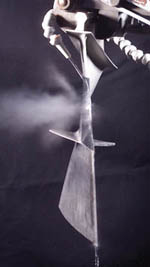Laser peening induces deep compressive stress, which significantly extends the service lifetime over any conventional treatment. 300 dpi image
Laser technology expected to produce major savings, reduced maintenance for commercial aircraft parts
LIVERMORE, Calif. - There's more life in store for critical components for commercial aircraft.That's the result of an advanced laser peening technology developed by researchers from Lawrence Livermore National Laboratory and a New Jersey firm.
The payoff is already proving to be huge: turbine engine parts that last longer, reduced maintenance costs, and annual savings of hundreds of millions of dollars.
The breakthrough that provides these benefits is a powerful LLNL laser and shock-generation technology used by Metal Improvement Co. Inc. of Paramus, N.J., to treat the surface of metal parts.
"This is 21st century technology that will enable engineers to design aircraft parts that are safer, lighter, perform better and are more economical," said Lloyd Hackel, leader of LLNL's Laser Science and Technology Program and initial developer of laser peening at LLNL.
During the past 21 months, Rolls-Royce plc has used Metal Improvement to laser peen critical fan blade components installed in over 250 Rolls-Royce Trent 800/Trent 500 engines.
Due to the deeper compressive residual stress imparted by the laser peening process, components are more resistant to fatigue stress,
improving the cost effectiveness of the operation of the component in terms of increased life and reduced maintenance costs. Other applications are under development for Rolls-Royce.
Traditionally, metals have been peened by bombarding the material with tiny metal balls known as "shot" to induce a layer of compressive stress at the surface that prevents metal fatigue and reduces corrosion. Metal Improvement is the world’s leading provider of outsourced shot peening services for the metal working industry.
Laser peening was invented in the 1970s, and uses short bursts of intense laser light to create pressure pulses on the metal surface, which generate shock waves that travel into the metal and compress it. However, this technology had never been used in production on commercial parts because of its high costs and slow lasers - until now.
Metal Improvement is using an LLNL-developed neodymium-doped glass laser that produces one billion watts of peak power, about the output of a large commercial power plant, in 20-billionth of a second bursts. With 125 watts of average power, the LLNL laser can fire five pulses per second compared with one pulse every four seconds for the best commercially available lasers.
The Livermore laser allows compressive stress to be imparted to a depth of 4/100ths of an inch beneath the surface, about four times deeper than conventional shot peening. This added depth is important as a means of inhibiting crack initiation and propagation.
Laser peening may find use in the future for upgrading other commercial aircraft components, such as discs, landing gears, spars, bulkheads and drive gears.
"We can 'surgically' apply laser peening and place compressive stress exactly in the areas that are vulnerable to crack propagation, thus strengthening these components," Hackel said.
"Overall, during the lifetime of all these laser-peened components, we anticipate savings to the aviation industry of hundreds of millions of dollars in reduced maintenance and fewer parts," said Dave Francis, Metal Improvement's executive vice-president for laser peening.
"We've been thrilled with the progress Metal Improvement has made on this technology, and as important as the current applications are, we believe it's only the tip of the iceberg," said Karena McKinley, the head of LLNL's Industrial Partnerships and Commercialization Program.
In the future, laser peening is expected by Hackel and Francis to be used in other industries, including automobiles and trucks, initially for high-performance race engines; components and structures for high-performance military jets; parts for deep-sea oil drilling equipment; welds for nuclear waste storage containers, and for medical devices such as knee and hip implants.
Livermore's technology for laser peening was licensed to Metal Improvement in 1997 and has been extended through joint research with the company during the past seven years.
During their collaboration, LLNL's Laser Science and Technology Division and Metal Improvement have won four prestigious R&D-100 awards for developing laser peening-related technologies. Metal Improvement’s manufacturing and processing facilities in Livermore, Calif., and Earby, U.K., each have two laser peening systems and about 35 employees.
" We wouldn't have been able to commercialize this technology without the Laboratory," Francis said. "In the early years, we relied heavily on the Lab's technological expertise, but the technology
transfer has evolved as Congress intended so that we've developed our own technological expertise, adding new capabilities and jobs to U.S. industry."
A spinoff of the Department of Energy's Inertial Confinement Fusion Program, the laser used for peening was developed at LLNL through funding from the Department of Defense, the Defense Advanced Research Projects Agency and the U.S. Air Force for X-ray lithography and satellite imaging research.
Founded in 1946, Paramus, N.J.-based Metal Improvement Co. Inc. is a subsidiary of Curtiss-Wright. The firm performs conventional shot peening - and laser peening - for the majority of aircraft engine and airframe builders worldwide.






